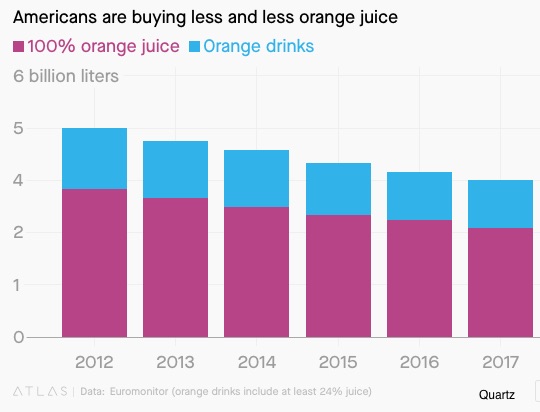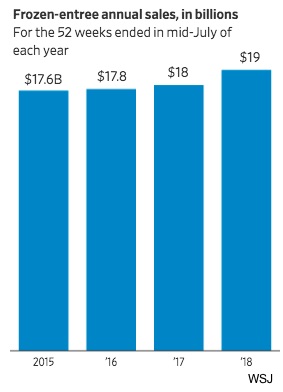The U.S Food & Drug Administration (FDA) might target plant based drinks that call themselves milk. Reminding us that his agency’s “standard of identity” for milk involves lactation, FDA head Scott Gottlieb memorably said “An almond doesn’t lactate.”
I suspect though that a new name won’t stop us from drinking our almond, hemp, or oat milk.
Where are we going? To new food preferences.
Meal Changes
Breakfast
Cereal and milk are less popular in the morning. Instead, we grab a health bar or open a container of yogurt:
Also, we are drinking less orange juice:
Lunch
Meanwhile, for lunch, when was the last time you had a tuna sandwich or some cottage cheese and fruit? Our cottage cheese intake is down from more than 5 pounds to approximately 2 pounds a person annually since the 1970s. But we are still eating bread and deli meats.
This is the decline in tuna consumption:
Dinner
Slightly on the rise now, our red meat consumption is down from 1980. But our chicken intake is up:
Meanwhile, frozen food entrees appear to be making a comeback. The reason could be new packaging and meals like the braised brisket, caramelized sweet potatoes, sorghum, red rice and pickled onions in a Wildscape container.
A new kind of container:
Frozen-entree sales:
Dessert
Because I love ice cream and eat it almost every day, it was a shocker to see its popularity is down here. But not in Asia:
Our Bottom Line: Changes in Demand
As economists we can say that a change in demand from new food preferences moves an entire demand curve:
 There are five basic reasons that the demand for a good or a service increases or decreases:
There are five basic reasons that the demand for a good or a service increases or decreases:
- Income goes up or down. Our spending power affects what we are willing and able to buy.
- A substitute or complementary product becomes more or less popular. When we want more chicken, then we buy less beef. For complements, if people want more chicken then maybe they buy more rice as a side dish.
- The “utility” of an item changes. When the utility of red meat drops because we think it is bad for our health, that means we experience less satisfaction from consuming it.
- More buyers enter the market.
So, where are we? Reducing the joy of new foods to economic jargon, we can say that the most likely reasons for our change in demand relate to substitutes, complements, and utility.
My sources and more: For new food preferences, Grubstreet sets the scene ideally. But then Quartz had the overview for each meal while the Washington Post and WSJ had the frozen food details.
The end of this post was slightly edited after publication.













